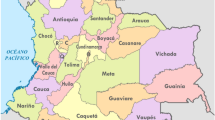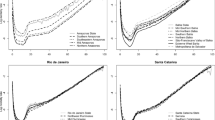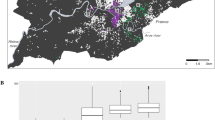Abstract
While studies of mortality have been gaining research attention worldwide, little attempt has been made to understand Canadian mortality rates from a spatial perspective. The objective of this research was to detect patterns in the spatial distribution of mortality rates for the sixty-five and older age group at the Canadian census division level. Specifically, the spatial patterns of mortality rates for Canadian males and females were examined using Moran’s I statistics, local indicators of spatial association, and cluster maps. The global Moran’s I tests of spatial autocorrelation suggest that Canadian mortality rates are spatially clustered, and further revealed the extent to which these spatial patterns remained consistent across the years in the study. These results were validated by local spatial modeling techniques, which were able to detect several areas in Canada where the mortality rates are clustered. This exploratory study revealed several regions of Canada which experience elevated mortality rates compared to the rest of the country, and provides a starting point for more nuanced investigations of mortality in Canada.
Résumé
Alors que les études de mortalité suscitent l’intérêt croissant des chercheurs partout dans le monde, rares sont les travaux permettant d’appréhender les taux de mortalité canadiens d’un point de vue géographique. Dans cette étude, nous avons cherché à dégager des profils dans la distribution spatiale des taux de mortalité des Canadiens et des Canadiennes de 65 ans et plus à l’échelle des divisions de recensement du pays. Pour analyser ces profils, nous nous sommes notamment appuyés sur l’indice de Moran, divers indicateurs locaux d’association spatiale ainsi que plusieurs cartes de groupement. Les tests globaux d’autocorrélation spatiale de l’indice de Moran montrent que les taux de mortalité sont géographiquement regroupés, et que cette distribution spatiale demeure constante au fil des ans. Les différentes techniques de modélisation spatiale locale nous ont non seulement permis de valider ces résultats, mais également d’identifier les territoires canadiens où les taux de mortalité sont regroupés. Cette étude exploratoire met en évidence plusieurs régions canadiennes où les taux de mortalité sont plus élevés qu’ailleurs dans le pays, et constitue un point de départ pour mener des recherches plus nuancées sur la mortalité au Canada.




Similar content being viewed by others
Availability of Data and Materials
The data that support the findings of this study are openly available in the public domain, and were obtained from Statistics Canada’s Annual Demographic Estimates at www150.statcan.gc.ca.
Notes
Mortality estimates were obtained on July 13, 2021, from www150.statcan.gc.ca/t1/tbl1/en/tv.action?pid=1710014001
Population estimates were obtained on July 13, 2021, from www150.statcan.gc.ca/t1/tbl1/en/tv.action?pid=1710013901
Due to availability of data, mortality rates were only determined for these binary sexes.
References
Adams, O. (1990). Life expectancy in Canada-an overview. Health Reports, 2(4), 361–376.
Anselin, L. (1995). Local indicators of spatial association-LISA. Geographical Analysis, 27(2), 93–115.
Bennett, J. E., Pearson-Stuttard, J., Kontis, V., Capewell, S., Wolfe, I., & Ezzati, M. (2018). Contributions of diseases and injuries to widening life expectancy inequalities in England from 2001 to 2016: A population-based analysis of vital registration data. The Lancet Public Health, 3(12), e586–e597.
Booth, H., & Tickle, L. (2008). Mortality modelling and forecasting: A review of methods. Annals of Actuarial Science, 3(1–2), 3–43.
Bushnik, T., Tjepkema, M., & Martel, L. (2020). Socioeconomic disparities in life and health expectancy among the household population in Canada. Health Rep, 31(1), 3–14.
Chagnon, J., Dion, P., Galbraith, N., Sirag, E., & Zhang, Y. (2020). Population projections for Canada (2018 to 2068), Provinces and Territories (2018 to 2043): Technical report on methodology and assumptions. Ottawa: Statistics Canada.
Cliff, A.D., & Ord, J.K. (1981). Spatial processes: models & applications. Taylor & Francis.
Corsi, D. J., Boyle, M. H., Lear, S. A., Chow, C. K., Teo, K. K., & Subramanian, S. (2014). Trends in smoking in Canada from 1950 to 2011: Progression of the tobacco epidemic according to socioeconomic status and geography. Cancer Causes & Control, 25(1), 45–57.
Crimmins, E. M. (2021). Recent trends and increasing differences in life expectancy present opportunities for multidisciplinary research on aging. Nature Aging, 1(1), 12–13.
Danesi, I., Haberman, S., & Millossovich, P. (2015). Forecasting mortality in subpopulations using Lee–Carter type models: A comparison. Insurance: Mathematics and Economics, 62, 151–161.
de Beer, J., & Janssen, F. (2016). A new parametric model to assess delay and compression of mortality. Population Health Metrics, 14(1), 46.
Decady, Y., & Greenberg, L. (2014). Ninety years of change in life expectancy. Report 82- 624-X. Ottawa: Statistics Canada.
Dion, P., & Galbraith, N. (2015). Back to the future: A review of forty years of population projections at Statistics Canada. Canadian Studies in Population, 42(1–2), 102–116.
Dwyer-Lindgren, L., Bertozzi-Villa, A., Stubbs, R. W., Morozoff, C., Kutz, M. J., Huynh, C., Barber, R. M., Shackelford, K. A., Mackenbach, J. P., van Lenthe, F. J., et al. (2016). US county-level trends in mortality rates for major causes of death, 1980–2014. JAMA, 316(22), 2385–2401.
Gompertz, B. (1825). On the nature of the function expressive of the law of human mortality, and on a new mode of determining the value of life contingencies. Philosophical Transactions of the Royal Society of London, 115, 513–583.
Greenberg, L., & Normandin, C. (2011). Disparities in life expectancy at birth. Report 82-624-X. Ottawa: Statistics Canada.
Griffith, D. (1999). Statistical and mathematical sources of regional science theory: Map pattern analysis as an example. Papers in Regional Science, 78(1), 21–45.
Ho, J.Y., & Hendi, A.S. (2018). Recent trends in life expectancy across high income countries: Retrospective observational study. BMJ, 362.
Kalkstein, L. S., & Greene, J. S. (1997). An evaluation of climate/mortality relationships in large US cities and the possible impacts of a climate change. Environmental Health Perspectives, 105(1), 84.
Lee, R., & Carter, L. (1992). Modeling and forecasting U.S. mortality. Journal of the American Statistical Association, 87(419), 659–671.
Li, N., & Lee, R. (2005). Coherent mortality forecasts for a group of populations: An extension of the Lee-Carter method. Demography, 42(3), 575–594.
Makeham, W. (1860). On the law of mortality and construction of annuity tables. Journal of the Institute of Actuaries, 8(6), 301–310.
McGeehin, M. A., & Mirabelli, M. (2001). The potential impacts of climate variability and change on temperature-related morbidity and mortality in the United States. Environmental Health Perspectives, 109(Suppl 2), 185.
Miller, H. (2004). Tobler’s first law and spatial analysis. Annals of the Association of American Geographers, 94(2), 284–289.
Moran, P. A. (1948). The interpretation of statistical maps. Journal of the Royal Statistical Society. Series B (Methodological), 10(2), 243–251.
O’Sullivan, D., & Unwin, D. (2014). Geographic information analysis. New York: John Wiley & Sons.
Public Health Agency of Canada (2018). Key health inequalities in Canada: A national portrait. Government of Canada.
Rasulo, D., Bajekal, M., & Yar, M. (2007). Inequalities in health expectancies in England and Wales-small area analysis from the 2001 census. Health Stat Q, 34(35), 35.
Shah, T. I., Bell, S., & Wilson, K. (2016). Spatial accessibility to health care services: Identifying under-serviced neighbourhoods in Canadian urban areas. PloS ONE, 11(12), e0168208.
Shahidi, F. V., Parnia, A., & Siddiqi, A. (2020). Trends in socioeconomic inequalities in premature and avoidable mortality in Canada, 1991–2016. CMAJ, 192(39), E1114–E1128.
Statistics Canada (2019). Changes in life expectancy by selected causes of death, 2017. Ottawa: Statistics Canada.
Statistics Canada (2019). Population projections for Canada (2018 to 2068), provinces and territories (2018 to 2043). Ottawa: Statistics Canada.
Statistics Canada (2020). Table 17–10-0139-01 Population estimates, July 1, by census division, 2016 boundaries. Ottawa: Statistics Canada.
Statistics Canada (2020). Table 17–10-0140-01 Components of population change by census division, 2016 boundaries. Ottawa: Statistics Canada.
Statistics Canada (2021). Table 13–10-0096-01 Health characteristics, annual estimates. Ottawa: Statistics Canada.
Statistics Canada (2021). Table 13–10-0114-01 Life expectancy and other elements of the complete life table, three-year estimates, Canada, all provinces except Prince Edward Island. Ottawa: Statistics Canada.
Statistics Canada (2022). Table 13–10-0394-01 Leading causes of death, total population, by age group. Ottawa: Statistics Canada.
Sui, D. (2004). Tobler’s first law of geography: A big idea for a small world? Annals of the Association of American Geographers, 94(2), 269–277.
Terashima, M., Guernsey, J. R., & Andreou, P. (2014). What type of rural? Assessing the variations in life expectancy at birth at small area-level for a small population province using classes of locally defined settlement types. BMC Public Health, 14(1), 1–10.
Tobler, W. (1979). Cellular geography. In Philosophy in Geography (pp 379–386). Springer.
Vanos, J. K., Cakmak, S., Bristow, C., Brion, V., Tremblay, N., Martin, S. L., & Sheridan, S. S. (2013). Synoptic weather typing applied to air pollution mortality among the elderly in 10 Canadian cities. Environmental Research, 126, 66–75.
Wang, H., Schumacher, A. E., Levitz, C. E., Mokdad, A. H., & Murray, C. J. (2013). Left behind: Widening disparities for males and females in US county life expectancy, 1985–2010. Population Health Metrics, 11(1), 1–15.
Acknowledgements
The authors would like to acknowledge the support of Saint Francis Xavier’s University Council for Research.
Funding
This research was supported by the Saint Francis Xavier University Council on Research grant.
Author information
Authors and Affiliations
Contributions
Dr. Cupido designed and directed the study. Ms. McClure contributed to the implementation of the research, to the collection of the data, and to the analysis of the results. Dr. Cupido prepared the manuscript in consultation with Ms. McClure.
Corresponding author
Ethics declarations
Competing Interests
The authors declare no competing interests.
Rights and permissions
About this article
Cite this article
Cupido, K., McClure, O. Spatio-temporal Analysis of Human Mortality in Canada. Can. Stud. Popul. 49, 183–198 (2022). https://doi.org/10.1007/s42650-022-00071-5
Received:
Accepted:
Published:
Issue Date:
DOI: https://doi.org/10.1007/s42650-022-00071-5




